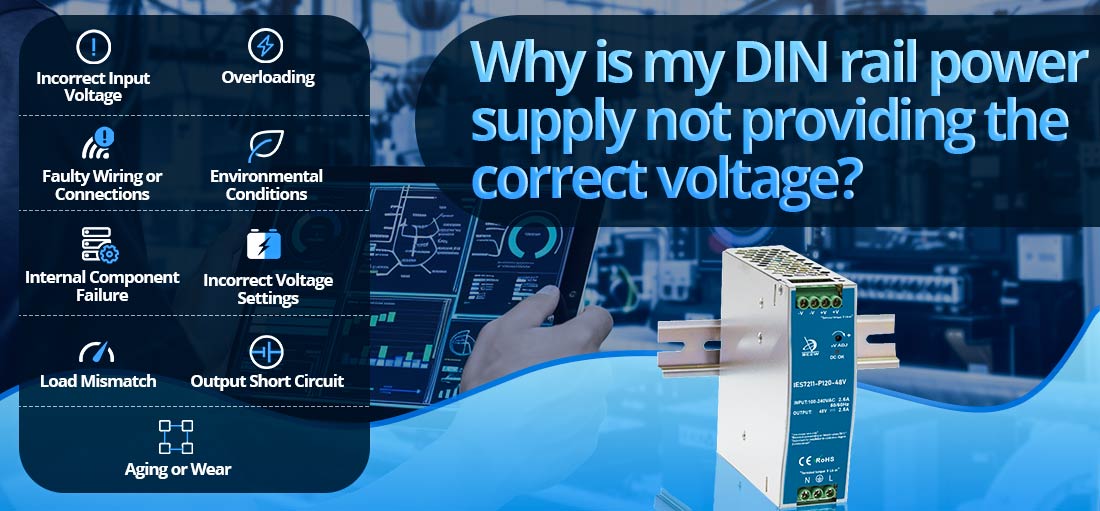
إذا كان مصدر طاقة السكك الحديدية DIN الخاص بك لا يوفر الجهد الصحيح، فقد يكون سبب ذلك عدة عوامل تتعلق بمصدر الطاقة نفسه، أو الحمل المتصل، أو بيئة التشغيل. فيما يلي شرح تفصيلي للأسباب المحتملة وخطوات التشخيص والحلول.
1. الأسباب المحتملة
1.1. جهد الإدخال غير صحيح
--- السبب: قد لا يتلقى مصدر الطاقة جهد الإدخال المناسب (التيار المتردد أو التيار المستمر) المطلوب للتشغيل.
--- التأثير: قد يؤدي الإدخال غير الكافي أو غير المستقر إلى منع مصدر الطاقة من توليد جهد الإخراج الصحيح.
1.2. الحمولة الزائدة
--- السبب: يتجاوز الحمل المتصل قدرة مصدر الطاقة، مما يؤدي إلى تقليل جهد الخرج كإجراء وقائي.
--- التأثير: يواجه مصدر الطاقة صعوبة في الحفاظ على الجهد المحدد.
1.3. الأسلاك أو التوصيلات الخاطئة
--- السبب: قد تؤدي الأسلاك السائبة أو المتآكلة أو المتصلة بشكل غير صحيح إلى تعطيل توصيل الجهد الكهربي.
--- التأثير: انخفاض الجهد أو عدم انتظام في أطراف الإخراج.
1.4. الظروف البيئية
--- السبب: يمكن أن تتداخل درجات الحرارة المرتفعة أو الرطوبة العالية أو الضوضاء الكهربائية في البيئة مع تشغيل مصدر الطاقة.
--- التأثير: قد لا تعمل المكونات الموجودة داخل مصدر الطاقة على النحو الأمثل، مما يؤدي إلى عدم استقرار الجهد.
1.5. فشل المكونات الداخلية
--- السبب: يمكن أن تمنع المكونات المعيبة مثل المكثفات أو المحولات أو أشباه الموصلات مصدر الطاقة من تنظيم الجهد بشكل صحيح.
--- التأثير: قد يكون جهد الخرج أقل أو أعلى أو متقلبًا.
1.6. إعدادات الجهد غير الصحيحة
--- السبب: تسمح بعض مصادر الطاقة بالتعديل اليدوي لجهد الخرج باستخدام مقياس الجهد. إذا كان الإعداد غير صحيح، فقد لا يتوافق الجهد مع التوقعات.
--- التأثير: جهد الخرج لا يتوافق مع المستوى المطلوب.
1.7. عدم تطابق التحميل
--- السبب: قد يكون للحمل متطلبات محددة، مثل التيار المستمر بدلاً من الجهد الثابت، والتي لا يستطيع مصدر الطاقة تلبيتها.
--- التأثير: أداء غير صحيح للحمل وقراءات جهد غير دقيقة.
1.8. ماس كهربائى الناتج
--- السبب: يؤدي وجود دائرة كهربائية قصيرة في الحمل المتصل أو الأسلاك إلى دخول مصدر الطاقة في وضع الحماية.
--- التأثير: يتم تقليل خرج الجهد أو إيقافه بالكامل.
1.9. الشيخوخة أو التآكل
--- السبب: بمرور الوقت، تتدهور المكونات، مما يقلل من قدرة مصدر الطاقة على الحفاظ على جهد ثابت.
--- التأثير: يصبح خرج الجهد غير موثوق به.
2. الخطوات التشخيصية
2.1. تحقق من جهد الإدخال
--- استخدم مقياسًا متعددًا لقياس جهد الإدخال للتأكد من أنه يلبي مواصفات مصدر الطاقة.
--- تأكد من أن مصدر الإدخال (على سبيل المثال، شبكة الكهرباء الرئيسية أو طاقة التيار المستمر) مستقر.
2.2. قياس الجهد الناتج
--- افصل الحمل وقم بقياس جهد الخرج مباشرة في أطراف إمداد الطاقة.
--- إذا كان الجهد صحيحًا بدون الحمل، فقد تكون المشكلة تتعلق بالحمل أو الأسلاك.
--- إذا كان الجهد لا يزال غير صحيح، فإن المشكلة تكمن في مصدر الطاقة.
2.3. فحص الأسلاك والاتصالات
--- تحقق من جميع أسلاك الإدخال والإخراج للتأكد من عدم وجود توصيلات فضفاضة أو تآكل أو تلف.
--- تأكد من تصنيف الأسلاك بشكل صحيح للمتطلبات الحالية.
2.4. تقييم الحمل
--- تأكد من أن إجمالي استهلاك الطاقة للأجهزة المتصلة يقع ضمن سعة مصدر الطاقة.
--- افصل الأجهزة الفردية لتحديد أي حمل خاطئ أو زائد.
2.5. التحقق من الظروف البيئية
--- تأكد من أن مصدر الطاقة يعمل ضمن نطاق درجة الحرارة والرطوبة المحدد له.
--- ابحث عن مصادر الضوضاء الكهربائية (على سبيل المثال، المحركات أو العاكسات القريبة) التي قد تتداخل مع التشغيل.
2.6. فحص إعدادات الجهد
--- بالنسبة لإمدادات الطاقة القابلة للتعديل، تأكد من ضبط مقياس الجهد بشكل صحيح على جهد الخرج المطلوب.
2.7. اختبار للدوائر القصيرة
--- افحص أسلاك الإخراج والأجهزة المتصلة بحثًا عن دوائر قصيرة محتملة باستخدام جهاز قياس متعدد.
2.8. فحص مصدر الطاقة
--- ابحث عن علامات التلف الظاهرة، مثل المكونات المحترقة أو المكثفات المنتفخة.
3. الحلول
3.1. إصلاح مشاكل جهد الإدخال
--- تأكد من أن مصدر طاقة الإدخال يلبي المواصفات المطلوبة.
--- استخدم مثبتًا أو مصدر طاقة غير منقطع (UPS) إذا كان جهد الإدخال غير مستقر.
3.2. تقليل الحمل
--- افصل الأحمال الزائدة لجعل إجمالي الطلب على الطاقة ضمن سعة مصدر الطاقة.
--- قم بالترقية إلى مصدر طاقة ذي تصنيف أعلى إذا لزم الأمر.
3.3. إصلاح الأسلاك
--- أحكم ربط الوصلات السائبة واستبدل أي أسلاك تالفة أو صغيرة الحجم.
3.4. تحسين الظروف البيئية
--- انقل مصدر الطاقة إلى بيئة أكثر تحكمًا، إن أمكن.
--- استخدم الدروع أو المرشحات لتقليل تأثير الضوضاء الكهربائية.
3.5. استبدال المكونات المعيبة
--- في حالة تلف المكونات الداخلية، قم بإصلاح مصدر الطاقة بواسطة فني مؤهل أو استبدله بالكامل.
3.6. إعدادات الجهد الصحيحة
--- ضبط الجهد الناتج الجهد إلى المستوى الصحيح لتطبيقك.
3.7. عنوان الدوائر القصيرة
--- إصلاح أو استبدال الأجهزة أو الأسلاك المعيبة التي تسبب قصر الدائرة.
3.8. استبدال إمدادات الطاقة القديمة
--- إذا كان مصدر الطاقة قديمًا أو متدهورًا بشكل كبير، فاستبدله بطراز جديد عالي الجودة.
4. التدابير الوقائية
--- اختر مصدر طاقة بسعة أعلى بنسبة 20-30% على الأقل من الحمل المتوقع.
--- فحص وصيانة الأسلاك والتوصيلات بانتظام.
--- تشغيل مصدر الطاقة ضمن مواصفاته البيئية والكهربائية.
--- استخدم واقيات التيار لحماية مصدر الطاقة من ارتفاع الجهد.
5. الاستنتاج
إذا كان لديك مصدر طاقة السكك الحديدية DIN لا يوفر الجهد الصحيح، فقد يكون ذلك بسبب مشكلات تتعلق بالطاقة المدخلة، أو ظروف الحمل، أو العوامل البيئية، أو فشل المكونات الداخلية. ومن خلال تشخيص هذه العوامل ومعالجتها بشكل منهجي، يمكنك استعادة التشغيل السليم أو تحديد متى يكون الاستبدال ضروريًا. الصيانة الدورية والتأكد من استخدام مصدر الطاقة ضمن معايير التصميم الخاصة به يمكن أن يمنع مشاكل الجهد في المستقبل.